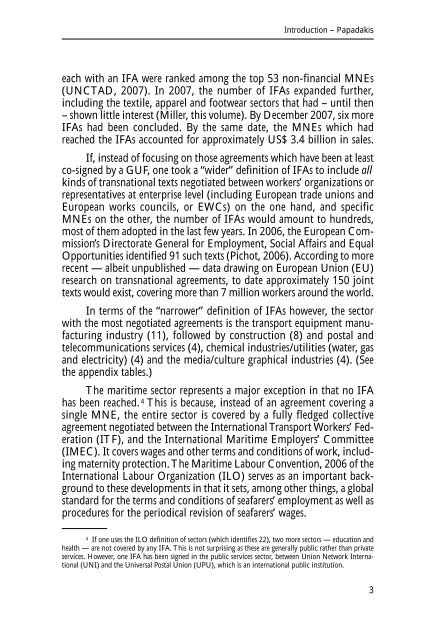CROSS-BORDER SOCIAL DIALOGUE AND AGREEMENTS: An ...
CROSS-BORDER SOCIAL DIALOGUE AND AGREEMENTS: An ...
CROSS-BORDER SOCIAL DIALOGUE AND AGREEMENTS: An ...
Create successful ePaper yourself
Turn your PDF publications into a flip-book with our unique Google optimized e-Paper software.
Introduction – Papadakis<br />
each with an IFA were ranked among the top 53 non-financial MNEs<br />
(UNCTAD, 2007). In 2007, the number of IFAs expanded further,<br />
including the textile, apparel and footwear sectors that had – until then<br />
– shown little interest (Miller, this volume). By December 2007, six more<br />
IFAs had been concluded. By the same date, the MNEs which had<br />
reached the IFAs accounted for approximately US$ 3.4 billion in sales.<br />
If, instead of focusing on those agreements which have been at least<br />
co-signed by a GUF, one took a “wider” definition of IFAs to include all<br />
kinds of transnational texts negotiated between workers’ organizations or<br />
representatives at enterprise level (including European trade unions and<br />
European works councils, or EWCs) on the one hand, and specific<br />
MNEs on the other, the number of IFAs would amount to hundreds,<br />
most of them adopted in the last few years. In 2006, the European Commission’s<br />
Directorate General for Employment, Social Affairs and Equal<br />
Opportunities identified 91 such texts (Pichot, 2006). According to more<br />
recent — albeit unpublished — data drawing on European Union (EU)<br />
research on transnational agreements, to date approximately 150 joint<br />
texts would exist, covering more than 7 million workers around the world.<br />
In terms of the “narrower” definition of IFAs however, the sector<br />
with the most negotiated agreements is the transport equipment manufacturing<br />
industry (11), followed by construction (8) and postal and<br />
telecommunications services (4), chemical industries/utilities (water, gas<br />
and electricity) (4) and the media/culture graphical industries (4). (See<br />
the appendix tables.)<br />
The maritime sector represents a major exception in that no IFA<br />
has been reached. 4 This is because, instead of an agreement covering a<br />
single MNE, the entire sector is covered by a fully fledged collective<br />
agreement negotiated between the International Transport Workers’ Federation<br />
(ITF), and the International Maritime Employers’ Committee<br />
(IMEC). It covers wages and other terms and conditions of work, including<br />
maternity protection. The Maritime Labour Convention, 2006 of the<br />
International Labour Organization (ILO) serves as an important background<br />
to these developments in that it sets, among other things, a global<br />
standard for the terms and conditions of seafarers’ employment as well as<br />
procedures for the periodical revision of seafarers’ wages.<br />
4<br />
If one uses the ILO definition of sectors (which identifies 22), two more sectors — education and<br />
health — are not covered by any IFA. This is not surprising as these are generally public rather than private<br />
services. However, one IFA has been signed in the public services sector, between Union Network International<br />
(UNI) and the Universal Postal Union (UPU), which is an international public institution.<br />
3
















